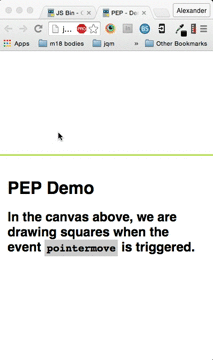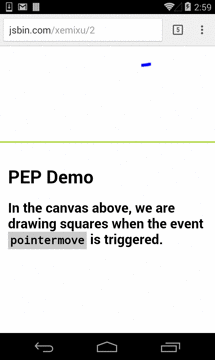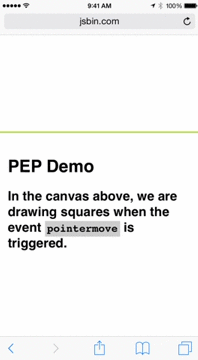Touch events have become a hot topic for web developers as more and more companies move into the mobile space. Most of us know that touch events support single and multi-touch tracking. Some of us know the trickiness of working with touch and mouse at the same time. Fewer know that there are multiple touch event models, and even fewer have tried to support multiple models at the same time. I’d like to talk about where we are today, how we got here, and the potential problems we may face in the future.
A Brief History
Back in 2007, Apple introduced the iPhone, and with it came touch events. Neil Roberts sums up the Apple implementation well in a SitePen article: “Though at first the APIs seem a little sketchy, once you’ve learned them you should be able to do amazing things in your application.” Sure enough, we’ve seen plenty of amazing things, without too much complaint of the “sketchy” API. This model was later implemented by Android, Nokia, RIM, Opera, and others. Apple’s implementation is still only available in their private fork of WebKit; it wasn’t until the end of 2009 that touch events first appeared in the main WebKit repo, coming from the Android implementation.
Also in 2009, the W3C started discussing a unified pointer model for DOM Level 3 Events. The idea was that touch (including multi-touch), pen/stylus, and mouse events would be coalesced into a single model, making it easy to support all pointer types at once. However, this was abandoned because the goal at the time was to keep the spec as small as possible in order to become a recommendation faster.
Another two years later (March 2011), Mozilla released Firefox 4, featuring their own flavor of touch events. The Mozilla model is much closer to the mouse event model and the abandoned W3C model in that the event objects are flat; properties such as event.pageX exist and there is no touch list. If you want to track multiple touches, you can do so via the event’s streamId. Mozilla later deprecated this implementation in favor of an emerging W3C spec based on Apple’s model.
In January 2011, the W3C started drafting a Touch Events spec based on the WebKit implementation. A few months later, it became a Working Draft, and in December it became a Candidate Recommendation. The next month, a Patent Advisory Group (PAG) was formed in order to investigate patents disclosed by Apple. Apple’s absence from the Touch Events Working Group (WG) and their patent disclosure has caused the W3C to stop work on the spec and they do not plan to continue until the PAG has concluded and/or makes a recommendation to the WG. As of this writing, the PAG has not made a decision about the impact of the patents, but the group’s goal is to reach a speedy conclusion.
Meanwhile, Microsoft took a different approach to touch and has implemented their own pointer events in IE10 with the MSPointerEvent object. The MSPointerEvent object is similar to the original Mozilla implementation, in that the event objects are flat and contain a pointerId property. However, there are some important differences between MSPointer and all of the other models, which are touch-specific.
Note: The above is just a brief history of touch events on the Web; if you’re interested in the history of touch interfaces, you might want to check out Bill Buxton’s Multi-Touch Systems that I Have Known and Loved.
Pointer Events vs. Touch Events
As mentioned above, generic pointer events such as the original W3C idea or MSPointer, have the benefit of supporting multiple pointer devices. In fact, with a Samsung tablet running Windows 8, mouse, pen, and fingers are all normalized to MSPointer; you can even use the pointerType property to determine which type of pointer is being used. In addition to supporting all current pointer devices, MSPointer is designed in such a way that future devices can easily be added, and existing code will automatically support the new device. Even better, MSPointer event objects have the same structure as other events, reducing the learning curve compared to the conglomerate of TouchEvent, TouchList, and Touch.
Another big difference between MSPointer and Touch is that MSPointer has support for hovering (over and out events). While most touch devices have a hardware limitation that doesn’t allow for hovering, Sony recently announced the Xperia sola with “magical floating touch technology.” This brings up an important issue: Touch Events were designed based on a specific device for a specific type of input. Pointer Events represent a completely different approach to input on the Web. While we’ve already covered how this impacts developers, it’s interesting to consider the impact on hardware manufacturers. In order for Apple to succeed with touch interfaces, they had to create a new event model. Innovation for new form factors and new input methods will either be stifled by the existing standards or will require a new set of APIs, following in Apple’s footsteps with the iPhone and Touch Events. Pointer Events provides a clean solution not only for developers, but for hardware manufacturers as well. It’s conceivable that in a few years developers could use Pointer Events as the only event model for pointers, leaving Mouse Events as a thing of the past.
A Splintered Future
Although the W3C is still planning to move forward with the Touch Events spec (pending a recommendation from the PAG), the future is unclear. Even if the PAG determines that Apple’s patents don’t apply and the spec becomes a W3C Recommendation, it’s not clear that Microsoft would implement such a model given the need for a multi-input event system in Windows. If the W3C were to change directions and start a Pointer Events spec, it’s not clear that Apple, or more broadly WebKit, would implement the new event model. It’s entirely possible that even with a W3C Recommendation, we’ll be stuck for years without a consistent event model across browsers and devices.
Regardless of which model the W3C chooses to pursue, jQuery is dedicated to filling in the gaps, just like we do for other events such as submit and change. We think the pointer event model is easier to use and more future-proof, and we hope that it can be standardized, even if Touch Events are standardized as well. However, we are only interested in normalizing to a W3C Recommendation, and will not provide custom pointer events if there is no official W3C specification. We’re working with the W3C and Microsoft to try to find the best way forward for our users and the Open Web.
Call to Action: Microsoft to Submit Pointer Event Proposal
We would like to publicly call upon Microsoft to submit a proposal to the W3C for Pointer Events. The Touch Events Working Group, and by extension various browser vendors, have stated interest in pointer events. The most effective way to proceed would be for Microsoft to officially submit a proposal to the W3C.
Call to Action: Community to Experiment with Both Event Models
We would also encourage the community to experiment with Touch and MSPointer. Play with the APIs, build apps, and provide feedback. If you’re interested in this, but don’t have the necessary hardware, consider pairing up with one or more local developers who do. While there are a lot of developers building on top of Touch, there are very few people building on top of MSPointer, and even fewer publicly comparing them. We encourage you to send your feedback directly to the W3C public-webevents mailing list, but feel free to leave feedback here and we will pass it along.
Call to Action: Submit Prior Art
If you know of any prior art for multi-touch/touch lists, even outside of the Web, please get in touch with the W3C. This includes programming models and APIs, especially those using events. This will help the Patent Advisory Group come to a conclusion sooner. Again, if you’d rather leave comments here, we will pass them along.


